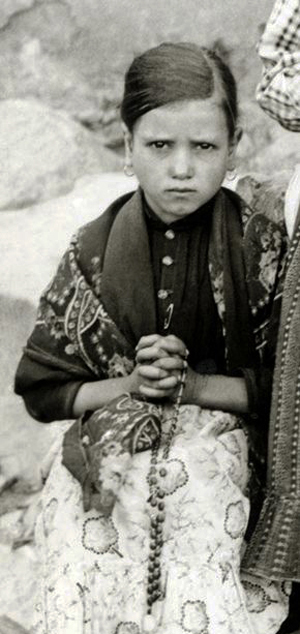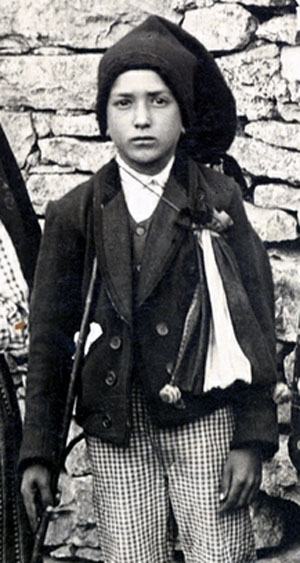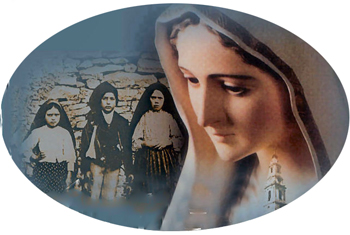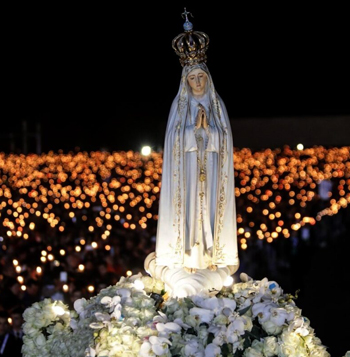Saints of the Day
 |
 |
 |
 |
 |
 |
 |
Jacinta & Francisco of Fatima - October 13
Biographical Selection:

 The true spiritual director of Jacinta, Francisco and Lucia essentially was Our Lady. The good Lady of the Cova da Iria took upon herself the realization of this masterpiece.
The true spiritual director of Jacinta, Francisco and Lucia essentially was Our Lady. The good Lady of the Cova da Iria took upon herself the realization of this masterpiece.
And, as it could not be otherwise, she accomplished that end with full success. From her prodigal hands came three Angels dressed in flesh who were, at the same time, three authentic heroes. The raw material – the three children – had an admirable willingness to be molded. And the Artist, what more can we say except she was Our Lady?
In her school the three shepherd children were soon taking giant steps on the path of perfection. In that school, the words of a great devotee of Mary, St. Louis Marie Grignion de Montfort, were fulfilled to the letter: "In the school of the Virgin the soul progresses more in one week than in one year anywhere else."
The pedagogy of the Mother of God is incomparable. In two years the Most Holy Virgin was able to bring the two siblings – Francisco and Jacinta – to the lofty summits of Christian sanctity. The portrait that the secure hand of Lucia sketches of Jacinta is revealing:
"Jacinta's demeanor was always serious and reserved, but friendly. All her actions seemed to reflect the presence of God in the way proper to persons already of mature age and great virtue. I have never seen in her that excessive frivolity or childish enthusiasm for games, jokes and pretty things, so typical of small children. ...
"I cannot say that the other children gathered around her, as they did around me. This was perhaps because there was in her a seriousness far beyond her years.
"If in her presence a child, or even an adult, were to say or do anything unseemly, she would reprimand them, saying: 'Do not do that, for you are offending the Lord our God, and He is already so much offended.'"
About Francisco, she writes that he was attracted to an ascetic and contemplative life.
Often he would disappear from sight, withdrawing to a secluded place in order to think. "What were you doing for so long?" Lucia would ask him, He would reply: "I was thinking about God who is so sad on account of so many sins. Jesus is so sad and I want to console Him with my prayer and penance."
One day when Lucia gave in to the urgings of her friends to take part in a local festival, Francisco sternly rebuked her action: "Are you going back to those parties and games? Have you already forgotten that we promised never to do that anymore?"
The three children would go to the church to spend long hours prostrate near the tabernacle. In particular, Jacinta and Francisco went more often to speak alone with the "Hidden Jesus." For they had the Virgin’s promise to come and take them to Heaven soon and thus considered themselves excused from the lessons at school.
Comments of Prof. Plinio:
These excerpts reveal a remarkable grace because they indicate many aspects – great and small – of the work Our Lady was doing with these three children. But we should consider, above all the symbolic value of the work of Our Lady in their souls. This was a work that from one moment to another suavely transformed the children by the simple fact of the repeated apparitions of Our Lady.

 We have here something similar to the Secret of Mary that works in souls spoken of by St. Louis Grignion de Montfort. That is, it was one of those profound actions of grace in the soul, actions that take place without the person even noticing. The person feels in himself an increasing freedom and is increasingly disentangled from obstacles to the practice of the good. The defects that thwart his progress and bind him to evil begin to dissolve by themselves.
We have here something similar to the Secret of Mary that works in souls spoken of by St. Louis Grignion de Montfort. That is, it was one of those profound actions of grace in the soul, actions that take place without the person even noticing. The person feels in himself an increasing freedom and is increasingly disentangled from obstacles to the practice of the good. The defects that thwart his progress and bind him to evil begin to dissolve by themselves.
The person grows in the love of God, in his self-dedication and opposition to sin. All this happens marvelously inside the soul in a way that is different from those great methodic battles of the spiritual ascent to Heaven of those who fight following the classical system of spiritual life. Rather, Our Lady changes them from one moment to another.
If the work of Our Lady in Fatima, especially with these two children called to Heaven, was a work of this kind, we can ask whether it has a symbolic value that indicates to us what the action of Our Lady over mankind will be when she fulfills the promise she made in Fatima of the triumph of her Immaculate Heart. Should we not see her work in these two souls an action that is a precursor of the Reign announced in Fatima?
Here there could be a beginning – one of many beginnings because enormous things have many beginnings – a beginning of the Reign of Mary, the triumph of the Immaculate Heart over two souls who were heralds of the great revelations of Our Lady at Fatima. Jacinta and Francisco are souls who, by their sacrifices and prayers on earth and then by their prayers in Heaven, helped and are still helping men on earth to accept the message of Fatima.
That is to say, we should see in this transformation – at least in a very probable way – a symbol of what will happen in the future. We must see a symbol in them of those profound transformations – probably amidst the most dramatic events of the Chastisement – that will mark the Reign of Mary.
This first observation leads directly to another thought: If this is so, then Jacinta and Francisco are the natural intercessors for us to ask Our Lady that the Reign of Mary begin in us as soon as possible through this mysterious transformation that is the Secret of Mary.
 Thus, we should insistently ask – of Jacinta as well as of Francisco – to assist us in this transformation and to grant us the gifts they received on earth. Let us ask them by their prayers in Heaven to watch over those who have the mission to spread the Fatima message and to live it, as we do.
Thus, we should insistently ask – of Jacinta as well as of Francisco – to assist us in this transformation and to grant us the gifts they received on earth. Let us ask them by their prayers in Heaven to watch over those who have the mission to spread the Fatima message and to live it, as we do.
In this regard, it is very important, I believe, to say a word on the relationship between the message of Fatima and the Counter-Revolution.
Among us it has been said a thousand times that our spiritual lives grow in proportion to how seriously we take the fact that the present-day world is in a deplorable decadence and approaching its total ruin. This near ruin already indicates the chastisement prophesied by Our Lady at Fatima. Consequently, the more we place ourselves in this perspective the more fervent our spiritual lives will be. On the contrary, the more we move away from this vision, the more our spiritual lives decay.
From Heaven Jacinta and Francisco contemplate Our Lord and Our Lady, whose Hearts are more and more offended. We should ask them from Heaven to pray that this torrent of offenses ceases so that, by some means, Our Lady can finally convert men.
Thus, through their mediation, we should appeal to Our Lady: "May thy Reign come to us - and soon! We ask insistently, vehemently, we beg that thy Reign may come down to us. We also beg thee, O Lady, to intervene in events, to obstruct the plans of your adversaries, to demolish absolutely and completely all their evil and sinful designs and to establish thy Reign on earth."

The Saint of the Day features highlights from the lives of saints based on comments made by the late Prof. Plinio Corrêa de Oliveira. Following the example of St. John Bosco who used to make similar talks for the boys of his College, each evening it was Prof. Plinio’s custom to make a short commentary on the lives of the next day’s saint in a meeting for youth in order to encourage them in the practice of virtue and love for the Catholic Church. TIA thought that its readers could profit from these valuable commentaries.
The texts of both the biographical data and the comments come from personal notes taken by Atila S. Guimarães from 1964 to 1995. Given the fact that the source is a personal notebook, it is possible that at times the biographic notes transcribed here will not rigorously follow the original text read by Prof. Plinio. The commentaries have also been adapted and translated for TIA’s site.

Jacinta, always a serious demeanor;
Francisco, the soul of a hermit

And, as it could not be otherwise, she accomplished that end with full success. From her prodigal hands came three Angels dressed in flesh who were, at the same time, three authentic heroes. The raw material – the three children – had an admirable willingness to be molded. And the Artist, what more can we say except she was Our Lady?
In her school the three shepherd children were soon taking giant steps on the path of perfection. In that school, the words of a great devotee of Mary, St. Louis Marie Grignion de Montfort, were fulfilled to the letter: "In the school of the Virgin the soul progresses more in one week than in one year anywhere else."
The pedagogy of the Mother of God is incomparable. In two years the Most Holy Virgin was able to bring the two siblings – Francisco and Jacinta – to the lofty summits of Christian sanctity. The portrait that the secure hand of Lucia sketches of Jacinta is revealing:
"Jacinta's demeanor was always serious and reserved, but friendly. All her actions seemed to reflect the presence of God in the way proper to persons already of mature age and great virtue. I have never seen in her that excessive frivolity or childish enthusiasm for games, jokes and pretty things, so typical of small children. ...
"I cannot say that the other children gathered around her, as they did around me. This was perhaps because there was in her a seriousness far beyond her years.
"If in her presence a child, or even an adult, were to say or do anything unseemly, she would reprimand them, saying: 'Do not do that, for you are offending the Lord our God, and He is already so much offended.'"
About Francisco, she writes that he was attracted to an ascetic and contemplative life.
Often he would disappear from sight, withdrawing to a secluded place in order to think. "What were you doing for so long?" Lucia would ask him, He would reply: "I was thinking about God who is so sad on account of so many sins. Jesus is so sad and I want to console Him with my prayer and penance."
One day when Lucia gave in to the urgings of her friends to take part in a local festival, Francisco sternly rebuked her action: "Are you going back to those parties and games? Have you already forgotten that we promised never to do that anymore?"
The three children would go to the church to spend long hours prostrate near the tabernacle. In particular, Jacinta and Francisco went more often to speak alone with the "Hidden Jesus." For they had the Virgin’s promise to come and take them to Heaven soon and thus considered themselves excused from the lessons at school.
Comments of Prof. Plinio:
These excerpts reveal a remarkable grace because they indicate many aspects – great and small – of the work Our Lady was doing with these three children. But we should consider, above all the symbolic value of the work of Our Lady in their souls. This was a work that from one moment to another suavely transformed the children by the simple fact of the repeated apparitions of Our Lady.

Our Lady, the true spiritual director of the Fatima children

The person grows in the love of God, in his self-dedication and opposition to sin. All this happens marvelously inside the soul in a way that is different from those great methodic battles of the spiritual ascent to Heaven of those who fight following the classical system of spiritual life. Rather, Our Lady changes them from one moment to another.
If the work of Our Lady in Fatima, especially with these two children called to Heaven, was a work of this kind, we can ask whether it has a symbolic value that indicates to us what the action of Our Lady over mankind will be when she fulfills the promise she made in Fatima of the triumph of her Immaculate Heart. Should we not see her work in these two souls an action that is a precursor of the Reign announced in Fatima?
Here there could be a beginning – one of many beginnings because enormous things have many beginnings – a beginning of the Reign of Mary, the triumph of the Immaculate Heart over two souls who were heralds of the great revelations of Our Lady at Fatima. Jacinta and Francisco are souls who, by their sacrifices and prayers on earth and then by their prayers in Heaven, helped and are still helping men on earth to accept the message of Fatima.
That is to say, we should see in this transformation – at least in a very probable way – a symbol of what will happen in the future. We must see a symbol in them of those profound transformations – probably amidst the most dramatic events of the Chastisement – that will mark the Reign of Mary.
This first observation leads directly to another thought: If this is so, then Jacinta and Francisco are the natural intercessors for us to ask Our Lady that the Reign of Mary begin in us as soon as possible through this mysterious transformation that is the Secret of Mary.

'May thy Reign on earth come - and soon!'
In this regard, it is very important, I believe, to say a word on the relationship between the message of Fatima and the Counter-Revolution.
Among us it has been said a thousand times that our spiritual lives grow in proportion to how seriously we take the fact that the present-day world is in a deplorable decadence and approaching its total ruin. This near ruin already indicates the chastisement prophesied by Our Lady at Fatima. Consequently, the more we place ourselves in this perspective the more fervent our spiritual lives will be. On the contrary, the more we move away from this vision, the more our spiritual lives decay.
From Heaven Jacinta and Francisco contemplate Our Lord and Our Lady, whose Hearts are more and more offended. We should ask them from Heaven to pray that this torrent of offenses ceases so that, by some means, Our Lady can finally convert men.
Thus, through their mediation, we should appeal to Our Lady: "May thy Reign come to us - and soon! We ask insistently, vehemently, we beg that thy Reign may come down to us. We also beg thee, O Lady, to intervene in events, to obstruct the plans of your adversaries, to demolish absolutely and completely all their evil and sinful designs and to establish thy Reign on earth."
 | |
|
|
The texts of both the biographical data and the comments come from personal notes taken by Atila S. Guimarães from 1964 to 1995. Given the fact that the source is a personal notebook, it is possible that at times the biographic notes transcribed here will not rigorously follow the original text read by Prof. Plinio. The commentaries have also been adapted and translated for TIA’s site.